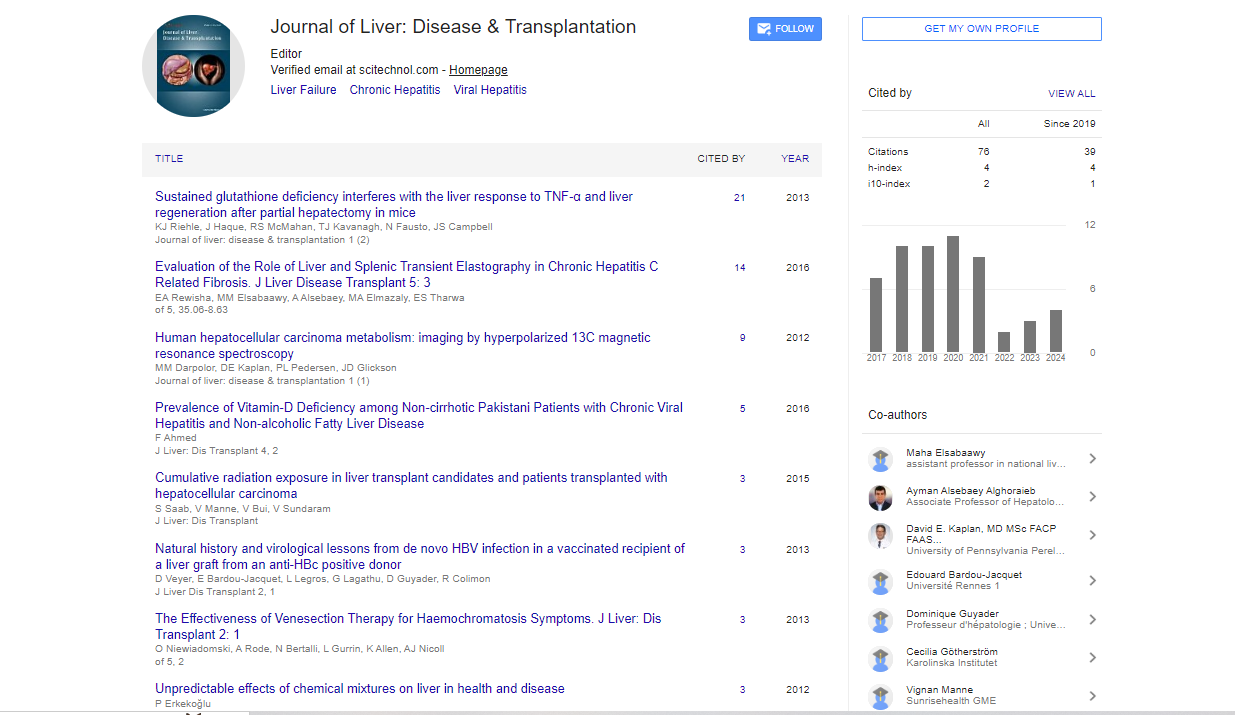Perspective, J Liver Disease Transplant Vol: 13 Issue: 2
Chronic Hepatitis D: Epidemiology, Diagnosis and Management Challenges
Jenin Strat*
1Department of Internal Medicine, National Taiwan University Hospital, Taipei, Taiwan
*Corresponding Author: Jenin Strat,
Department of Internal Medicine, National
Taiwan University Hospital, Taipei, Taiwan
E-mail: stratje@je.tw
Received date: 27 May, 2024, Manuscript No. JLDT-24-146986;
Editor assigned date: 30 May, 2024, PreQC No. JLDT-24-146986 (PQ);
Reviewed date: 13 June, 2024, QC No. JLDT-24-146986;
Revised date: 21 June, 2024, Manuscript No. JLDT-24-146986 (R);
Published date: 28 June, 2024, DOI: 10.4172/2325-9612.1000263
Citation: Strat J (2024) Chronic Hepatitis D: Epidemiology, Diagnosis and Management Challenges. J Liver Disease Transplant 13:2.
Description
Chronic Hepatitis D (CHD), caused by the Hepatitis D Virus (HDV), is a significant global health concern, particularly in regions with high prevalence. This condition occurs only in the presence of Hepatitis B Virus (HBV) infection, as HDV is a defective virus that requires HBV for its replication and persistence. Understanding the epidemiology, diagnostic approaches and management challenges of CHD is an important for improving patient outcomes and public health strategies. CHD is less common than Hepatitis B and C but has a substantial impact on those affected. The global prevalence of HDV varies widely, with significant geographic and demographic differences. High-prevalence areas include parts of Africa, the Middle East and Central and South America, where HBV infection is endemic. In these regions, the co-infection rate of HBV and HDV can be substantial, leading to more severe liver disease and poorer outcomes compared to HBV monoinfection. In Europe and North America, HDV prevalence is lower, but the condition remains a concern among highrisk populations, including individuals with HBV-related liver disease, people who inject drugs and those with a history of multiple sexual partners or high risk behaviors. Migrant populations from highprevalence regions may also contribute to local cases of CHD.
Diagnosing CHD involves several steps, beginning with identifying the presence of both HBV and HDV infections. The diagnosis of HDV infection starts with serological tests. The presence of anti-HDV antibodies (anti-HDV) in the serum indicates exposure to HDV. To confirm active infection, testing for HDV Ribonucleic Acid (RNA) is required. This molecular test detects viral genetic material and confirms active replication of HDV. Additionally, HBV surface Antigen (HBsAg) testing is necessary, as HDV cannot replicate without without HBV. Assessing liver function through blood tests helps evaluate the extent of liver damage. Elevated liver enzymes and bilirubin levels, along with low albumin levels, can indicate ongoing liver inflammation or damage. Imaging studies, such as ultrasonography, elastography may be used to assess liver fibrosis or cirrhosis, which are common complications of chronic HDV infection. In certain cases, a liver biopsy may be performed to determine the degree of liver inflammation and fibrosis. Non-invasive methods, such as transient elastography (FibroScan), are increasingly used to assess liver stiffness and fibrosis.
Managing CHD presents several challenges, primarily due to the limited availability of effective treatments and the complexity of coinfection with HBV. Unlike Hepatitis B and C, there are fewer antiviral options specifically approved for treating HDV infection. Pegylated Interferon-alpha (PEG-IFN-α) is currently the primary treatment, but its efficacy is limited and it is associated with significant side effects, including flu-like symptoms, depression and neutropenia. The response rate to PEG-IFN-α is variable and Sustained Virologic Response (SVR) is achieved in a subset of patients. The use of Nucleotide Analogues (NAs) like tenofovir or entecavir, which are effective against HBV, may also benefit patients with HBV/HDV co-infection by reducing HBV replication. However, these medications do not target HDV directly and may not fully suppress HDV replication or improve liver outcomes in all cases.
Developing resistance to antiviral therapy is a concern, particularly with long-term treatment. Adherence to treatment regimens can be challenging due to the side effects of interferon therapy and the need for regular monitoring. Ensuring patient adherence and managing side effects are essential aspects of successful treatment. Regular monitoring is essential to assess treatment response and manage potential complications. This includes routine testing for HDV RNA, liver function tests and monitoring for adverse effects of treatment. Long-term follow-up is necessary to detect any progression of liver disease and adjust treatment as needed. In cases of advanced liver disease or cirrhosis, liver transplantation may be considered. However, managing HDV in the transplant setting is challenging, as HDV can reinfect the new liver. Preventive strategies, such as using antiviral agents or post-transplant prophylaxis with anti-HDV treatments, are areas of ongoing study.
Conclusion
CHD represents a significant challenge in the management of viral liver diseases, with its impact on liver health and treatment complexities. Understanding the epidemiology, advancing diagnostic techniques are important for improving health. Ongoing study and development of new therapies are important for controlling HDV infection and reducing the chronic Hepatitis D.
 Spanish
Spanish  Chinese
Chinese  Russian
Russian  German
German  French
French  Japanese
Japanese  Portuguese
Portuguese  Hindi
Hindi 